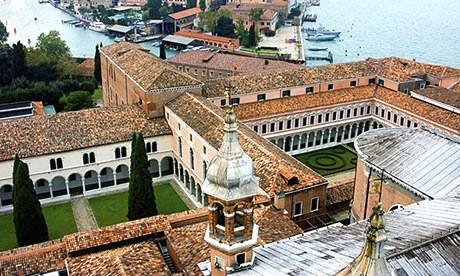
Around £6,000 buys a trip for two on the Orient Express from London to Venice, a private launch and two nights at Hotel Cipriani, with the promise of “an atmosphere of calm and seclusion”. For about £5,500 less, two people can take an ordinary train to Venice (raileurope.com, fares from London start at £98.50) a vaporetto instead of a water taxi, and stay next door to the “Cip”, on a more secluded island, with equally romantic views.
Instead of braying jetsetters, you will be staying with the monks of San Giorgio Maggiore, the 16th-century monastery and church seen on so many paintings and photographs.
As you leave Santa Lucia station take vaporetto number 2 down the Grand Canal to San Giorgio. On arrival, you ring a buzzer, marked Monaci Benedittine (Benedictine monks), on the heavy door to the right of the white church. There’s no checking in; you will simply be led up some worn stone steps to your quiet room.
Huge paintings by Tintoretto hang on the monastery walls, and history hangs heavy too: in 1800 Pope Pius VII was elected here. Its bell tower offers possibly the best views of Venice. At night, when the day-trippers have left, the island is peaceful, with just the lapping of waves against steps. In the chapel, the monks might be chanting. You are welcome to join them.
There are just five guest rooms. Ours had a balcony with a view of St Mark’s, a tiled floor, a high ceiling, an en suite shower, a desk and two single beds, monastically firm and narrow but comfortable. There was also a book, The Rule of St Benedict (in Italian), and a crucifix. You don’t have to take a vow of silence or abstinence; there’s no need to be monk-like or even vaguely religious (or male, come to that).
In the morning, Dom Andrew McNeill, the British guest master, sets a communal table for breakfast with croissants, cereal and yoghurt. Dressed in a brown habit, he tells us that this is the world’s longest continually operating Benedictine abbey, offering hospitality since 982.
“The rule of St Benedict is that we welcome strangers as if they are Christ,” he says. “The ‘Dom’ stands for dominus – Lord,” he adds. “But you don’t call me Dom – Andrew will do.” He tells of his life – pre-vows, 30 years ago – as an interior designer in London.
Only two other monks live permanently at the monastery, though others visit. For lunch, Andrew recommends a cheap workers’ cafe on neighbouring Giudecca island and suggests we buy provisions at the Rialto market to cook for dinner in the small communal kitchen.
Obediently we go to the cafe, Food & Art (Corte Cordami, 554 Giudecca, open Mon-Fri, lunchtimes only). It’s a mensa (canteen) for workmen at the Giudecca boatyards, which also doubles as an art gallery, and we share a tomato and mozzarella salad with bread for €6, though there is the option of a full meal for €12.
At the market, we buy fruit and vegetables – celery, onions, fresh and dried tomatoes, artichokes, oranges, apples, bananas – for €10 and wine on tap for €2 a litre from El Vin del Patron on Calle degli Oresi. That evening, we enjoy a simple meal on our balcony, looking over a low parapet towards St Mark’s Square.
• The monastery has no website or email. Book by calling +39 041 241 4717, or send a fax to +39 041 520 6579. There’s no set rate; you make a cash “offerta” of what you can afford when you leave (we paid €80 a night)

